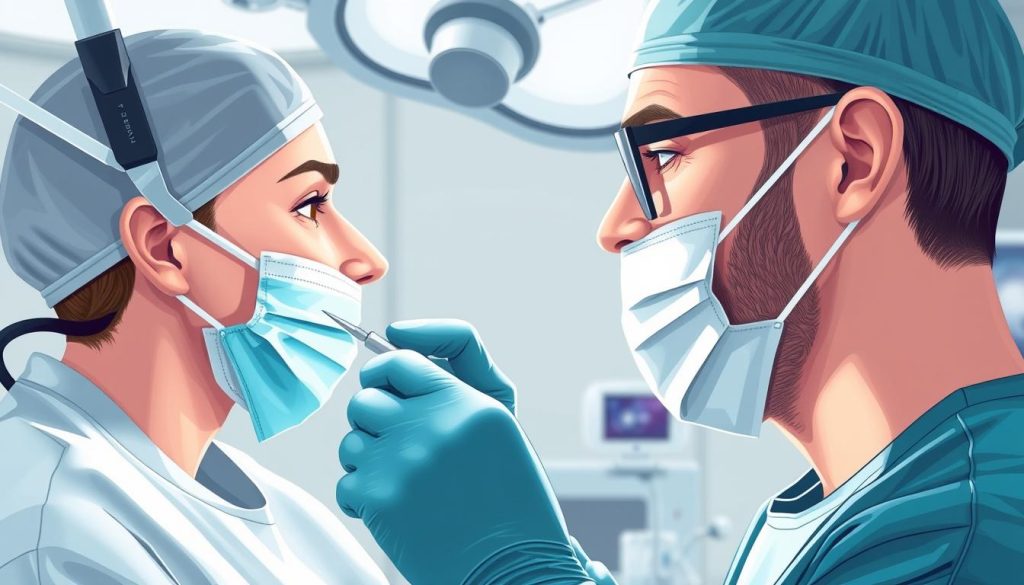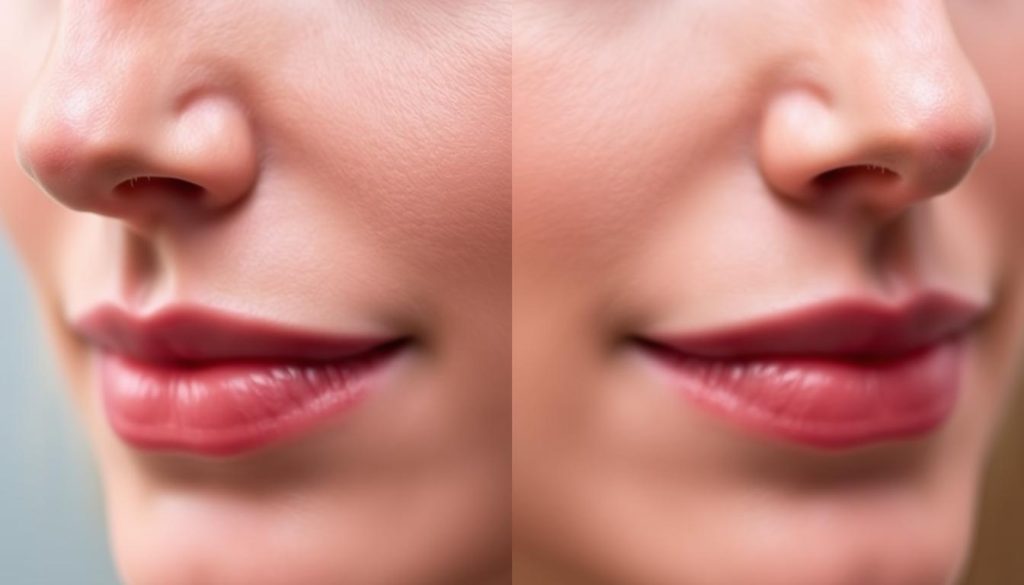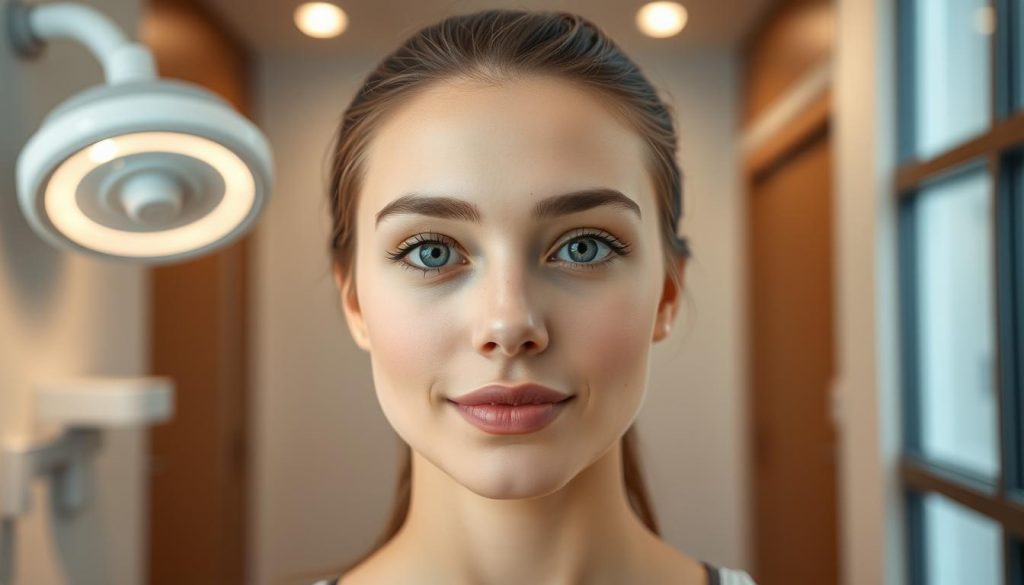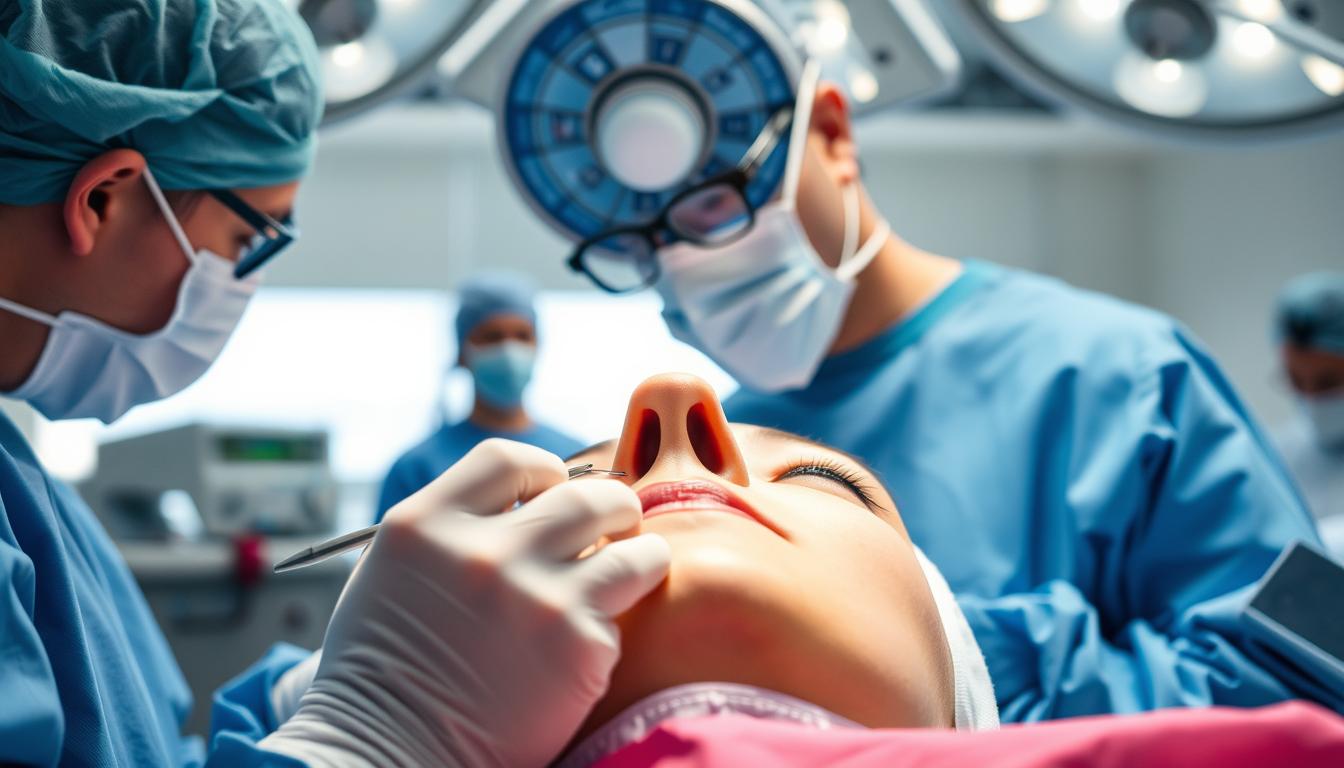Rhinoplasty, commonly known as a “nose job,” is a popular surgical procedure for individuals unhappy with the size or shape of their nose. This facial plastic surgery has evolved to offer both cosmetic and functional benefits, improving not only the appearance of the nose but also addressing issues such as breathing difficulties.
The rhinoplasty surgery is a complex operation that requires precision and expertise. By understanding what the procedure entails, individuals can make informed decisions about undergoing a surgical nose lift.
Key Takeaways
- Rhinoplasty is a versatile surgical procedure that offers both cosmetic and functional benefits.
- The surgery can improve the appearance of the nose and address breathing difficulties.
- A successful rhinoplasty requires precision and expertise.
- Understanding the procedure is crucial for making informed decisions.
- Rhinoplasty can be a life-changing surgery for individuals unhappy with their nose.
Understanding Surgical Nose Lift: What is Rhinoplasty?

For individuals seeking to improve the appearance or function of their nose, rhinoplasty offers a comprehensive solution that combines aesthetic and medical benefits. This surgical procedure is designed to address a range of concerns, from cosmetic issues to functional problems that affect breathing.
Definition and Purpose of Rhinoplasty
Rhinoplasty, commonly referred to as a nose job, is a surgical intervention aimed at modifying the shape, size, or function of the nose. The primary purpose of this procedure is to either enhance the aesthetic appeal of the nose or to correct functional issues, such as those related to a deviated septum.
Functional vs. Cosmetic Rhinoplasty
There are two main types of rhinoplasty procedures: functional and cosmetic. Functional rhinoplasty focuses on improving nasal breathing and function, often involving the correction of a deviated septum or repair of nasal valve collapse. Cosmetic rhinoplasty, on the other hand, is performed to enhance the aesthetic appearance of the nose. Many procedures combine both functional and cosmetic elements to improve both breathing and appearance simultaneously.
- Functional rhinoplasty focuses primarily on improving nasal breathing and function rather than appearance.
- This type often involves correcting a deviated septum (septoplasty), repairing nasal valve collapse, or addressing other structural issues that impair breathing.
- Cosmetic rhinoplasty, by contrast, is performed to enhance the aesthetic appearance of the nose without necessarily addressing functional concerns.
- Many rhinoplasty procedures combine both functional and cosmetic elements to improve both breathing and appearance simultaneously.
- Insurance may cover functional rhinoplasty procedures when medically necessary, while purely cosmetic procedures are typically self-paid.
Benefits of Rhinoplasty Surgery
The benefits of rhinoplasty surgery are multifaceted, improving not only the aesthetic appeal of the face but also the overall quality of life for patients. When performed by a skilled, qualified cosmetic surgeon, rhinoplasty can be a rewarding and life-enhancing procedure.
Aesthetic Improvements
Rhinoplasty can significantly enhance the appearance of the nose, making it more harmonious with other facial features. Patients often notice that their overall appearance has improved, as the nose looks natural, like the nose they have always thought they should have.

Functional Benefits
In addition to aesthetic improvements, rhinoplasty can also address functional issues, such as breathing difficulties. By correcting nasal obstructions, patients can experience improved respiratory function, leading to better overall health.
Psychological Impact
The psychological benefits of rhinoplasty should not be underestimated. Many patients report significant improvements in self-confidence and self-esteem following successful rhinoplasty. Addressing long-standing insecurities about nasal appearance can reduce social anxiety and improve quality of life. Studies show that rhinoplasty has one of the highest satisfaction rates among cosmetic procedures, with most patients reporting they would undergo the procedure again.
Types of Surgical Nose Lift Procedures
Various rhinoplasty techniques are available, providing flexibility in achieving the desired nasal shape and function. These procedures can be tailored to address both aesthetic and functional concerns.
Open Rhinoplasty
Open rhinoplasty involves making an incision between the nostrils, allowing for greater visibility and access to the nasal structures. This approach is often used for complex cases or when significant changes are required.
Closed Rhinoplasty
Closed rhinoplasty involves making incisions within the nostrils, resulting in no visible scarring. This technique is suitable for less complex cases and can lead to a quicker recovery.
Tipplasty
Tipplasty focuses specifically on reshaping the nasal tip. It is a less invasive procedure, ideal for patients who only need adjustments to this area.
Non-Surgical Rhinoplasty Options
Non-surgical rhinoplasty uses dermal fillers to temporarily alter the nose’s appearance. This approach can effectively camouflage bumps, improve symmetry, and enhance the bridge contour. Results typically last 6-12 months.
- Non-surgical rhinoplasty uses injectable dermal fillers to temporarily alter the nose’s appearance without incisions or downtime.
- This approach can effectively camouflage bumps, improve symmetry, lift the nasal tip, and enhance the bridge contour.
- Results typically last 6-12 months depending on the type of filler used and the patient’s metabolism.
Ideal Candidates for Rhinoplasty
Understanding the characteristics of an ideal rhinoplasty candidate is crucial for achieving successful results. A rhinoplasty can significantly enhance the appearance and function of the nose, but it’s essential to identify the right candidates for the procedure.
Age Considerations
The age of the patient is a critical factor in determining suitability for rhinoplasty. Generally, surgeons recommend that patients be at least 16 years old for girls and 17 or 18 for boys, as facial growth is typically complete by these ages. However, the ideal age can vary based on individual development and the specific reasons for undergoing the surgery.
Health Requirements
Good health is a prerequisite for undergoing rhinoplasty. Patients should be free from serious medical conditions that could complicate surgery or the healing process. A thorough evaluation by a qualified surgeon is necessary to assess overall health and determine suitability for the procedure.
Realistic Expectations
Having realistic expectations is vital for patients considering rhinoplasty. The procedure can improve the appearance and function of the nose, but it cannot achieve perfection. A skilled surgeon will help patients understand what can be achieved and ensure that the results are natural-looking and in harmony with their other facial features.

- Ideal candidates understand that rhinoplasty aims to improve, not perfect, the nose’s appearance or function.
- Patients should have specific, realistic goals rather than seeking a “perfect” nose or wanting to look exactly like someone else.
- Understanding that final results may take up to a year to fully manifest as swelling gradually subsides is important.
The Rhinoplasty Consultation Process

Patients considering rhinoplasty should start by scheduling a consultation with a board-certified plastic surgeon. This initial meeting is crucial for understanding the patient’s needs and expectations.
What to Expect During Your Initial Consultation
During the consultation, the surgeon will assess the patient’s nose and discuss their goals for the surgery. The surgeon will also explain the potential risks and benefits associated with rhinoplasty.
Important Questions to Ask Your Surgeon
Patients should come prepared with questions for their surgeon, including inquiries about the surgeon’s experience with rhinoplasty, the type of anesthesia used, and what to expect during recovery. Asking about the surgeon’s approach to achieving the desired nose looks is also crucial.
3D Imaging and Pre-Surgical Planning
Many modern rhinoplasty practices utilize 3D imaging technology to simulate potential surgical outcomes. At UT Southwestern, 3D imaging is used prior to surgery to show patients how their nose might look after surgery. The plastic surgeon can print models of the nose as it looks before rhinoplasty surgery alongside the expected appearance after surgery. This technology allows patients to visualize different possible results and provide feedback before any actual changes are made.
The Surgical Nose Lift Procedure
Understanding the surgical process of rhinoplasty is crucial for patients considering this form of plastic surgery. The procedure involves several key steps and considerations.
Anesthesia Options
Rhinoplasty can be performed under local or general anesthesia, depending on the complexity of the procedure and the patient’s preference. The choice of anesthesia is discussed during the pre-surgical consultation.
Step-by-Step Surgical Process
The rhinoplasty surgery involves making precise incisions, either within the nostrils or across the columella, to access the nasal structures. The surgeon then reshapes the bone and cartilage to achieve the desired outcome.
Duration and Hospital Stay
A typical procedure takes between 1.5 to 3 hours to complete. Most rhinoplasty surgeries are performed as outpatient surgery, allowing patients to return home the same day. However, patients must arrange for someone to drive them home and stay with them overnight.
- The surgical facility monitors patients in recovery for several hours after surgery to ensure stable vital signs and proper pain management.
- In rare cases, an overnight hospital stay might be required for extensive reconstruction or when combined with other procedures.
Recovery and Healing After Rhinoplasty
Understanding the recovery and healing process after rhinoplasty is essential for patients to ensure a smooth and effective healing journey. The recovery period is a critical time that requires careful management to achieve the best possible outcome.
Immediate Post-Op Care
Immediately after rhinoplasty surgery, patients need to follow specific care instructions to minimize complications and promote healing. This includes resting, applying ice packs to reduce swelling, and keeping the head elevated.
Stages of Swelling and Healing
For the first 1 to 2 weeks, many patients experience bruising and swelling. The majority of bruising and swelling should subside after the first 10 to 14 days.
Timeline for Returning to Normal Activities
Most patients feel ready to return to work or school after 1 or 2 weeks, depending on the level of activity required. Typically, after 3 weeks, most normal non-contact activities can be resumed. However, it’s crucial to limit activity according to the surgeon’s instructions and avoid strenuous activities until cleared.
- Return to desk work or school within 7-10 days, though some bruising may remain.
- Resume light walking and daily activities after the first week, avoiding heavy lifting.
- Avoid strenuous exercise and aerobic activities for at least 3-4 weeks.
Making an Informed Decision About Rhinoplasty
When considering rhinoplasty, it’s crucial to weigh the potential benefits against the limitations. Patients should research qualified facial plastic surgeons who specialize in rhinoplasty surgery and have extensive before-and-after portfolios. Understanding that rhinoplasty results are permanent is vital.
Realistic expectations about outcomes, recovery time, and potential complications are essential for satisfaction with the procedure. Patients should consider timing factors such as upcoming major life events and work obligations when scheduling surgery. A comprehensive consultation with a board-certified cosmetic surgeon is the best way to determine if rhinoplasty is right for you.
The decision to undergo a nose job should be made for personal satisfaction, not to please others or achieve an idealized image from social media. By being informed and prepared, patients can achieve the desired results from their cosmetic surgery.
FAQ
What is the difference between open and closed rhinoplasty?
Open rhinoplasty involves making an incision between the nostrils, allowing for more complex changes, while closed rhinoplasty involves incisions within the nostrils, resulting in less visible scarring and a faster recovery.
How long does it take to recover from a rhinoplasty procedure?
The initial recovery period typically lasts one to two weeks, but it may take several months for the swelling to fully subside and the final results to become apparent.
Can rhinoplasty improve breathing difficulties?
Yes, rhinoplasty can address functional issues, such as a deviated nasal septum, to improve breathing and overall respiratory function.
What are the benefits of using dermal fillers as a non-surgical rhinoplasty option?
Dermal fillers can provide a temporary solution for minor imperfections, allowing patients to test the appearance of their nose without committing to surgery.
How is the septum addressed during rhinoplasty surgery?
The surgeon will assess the septum and perform any necessary corrections, such as septoplasty, to improve breathing and overall nasal function.
Can rhinoplasty be performed on patients with previous facial plastic surgery?
Yes, but it’s crucial to discuss previous procedures with the surgeon to determine the best approach and potential limitations.
What is the role of cartilage in rhinoplasty surgery?
Cartilage is often used as grafting material to enhance the shape and structure of the nose, providing support and definition.
How do surgeons determine the ideal shape and size of the nose for each patient?
Surgeons work closely with patients to understand their aesthetic goals and use their expertise to create a personalized plan, taking into account facial proportions and individual characteristics.
